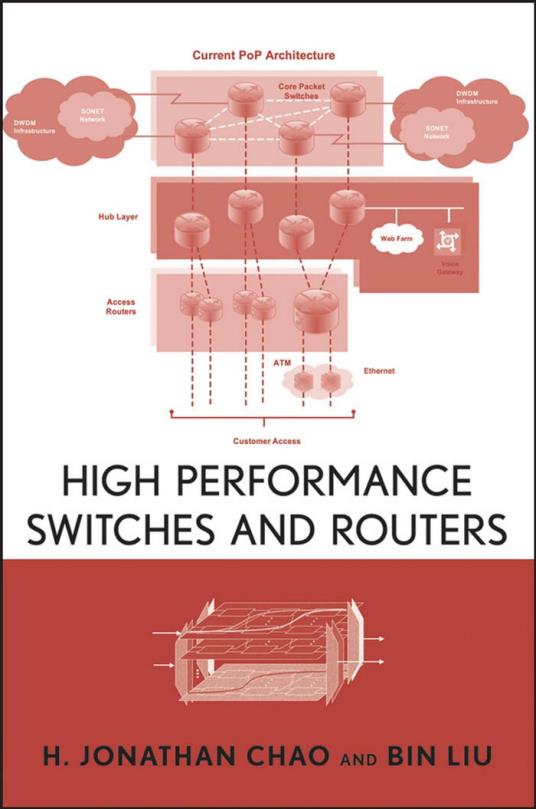
Current PoP Architecture Core Packet Hub Layer 阿 Routers ATM Ethernet Customer Access HIGH PERFORMANCE SWITCHES AND ROUTERS H.JONATHAN CHAO AND BIN LIU
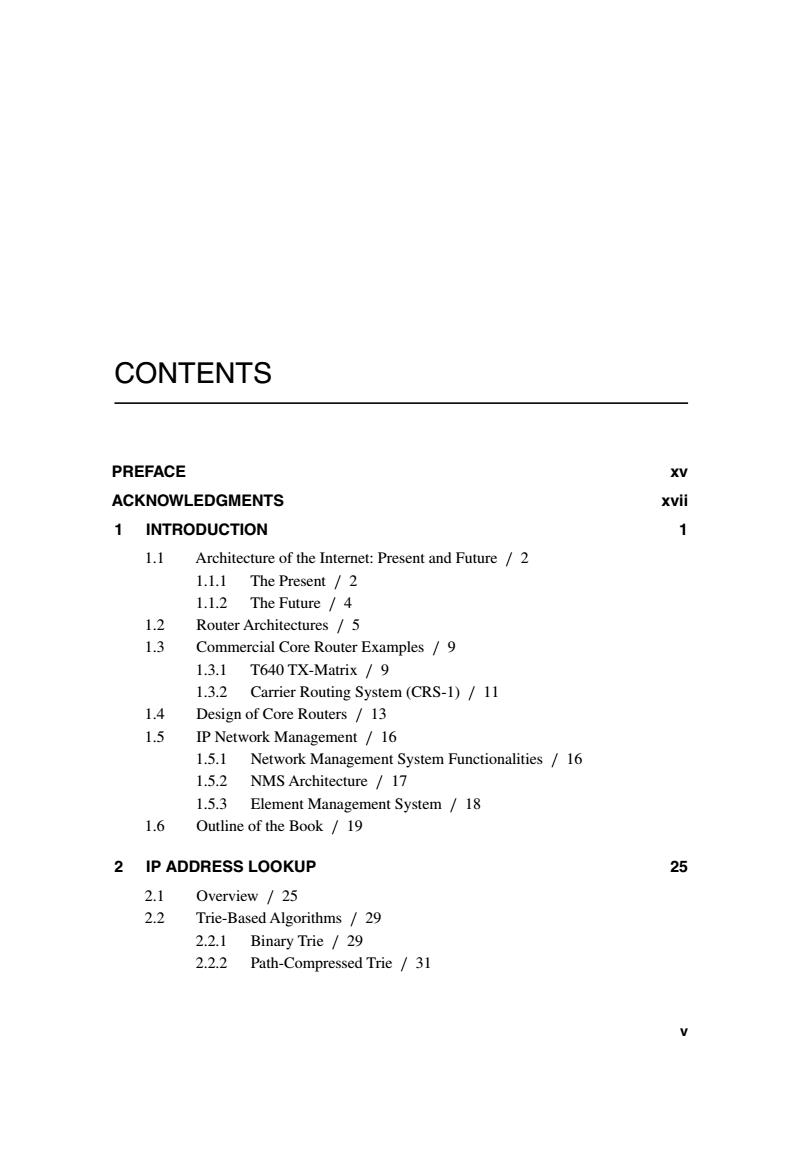
CONTENTS PREFACE XV ACKNOWLEDGMENTS xvii 1 INTRODUCTION 1 1.1 Architecture of the Internet:Present and Future /2 1.1.1 The Present /2 1.1.2 The Future /4 1.2 Router Architectures /5 1.3 Commercial Core Router Examples /9 1.3.1 T640 TX-Matrix /9 1.3.2 Carrier Routing System(CRS-1)/11 1.4 Design of Core Routers /13 1.5 IP Network Management 16 1.5.1 Network Management System Functionalities 16 1.5.2 NMS Architecture /17 1.5.3 Element Management System 18 1.6 Outline of the Book /19 2 IP ADDRESS LOOKUP 25 2.1 Overview /25 2.2 Trie-Based Algorithms /29 2.2.1 Binary Trie /29 2.2.2 Path-Compressed Trie /31
Book1099 — “ftoc” — 2007/2/16 — 21:26 — page v — #1 CONTENTS PREFACE xv ACKNOWLEDGMENTS xvii 1 INTRODUCTION 1 1.1 Architecture of the Internet: Present and Future / 2 1.1.1 The Present / 2 1.1.2 The Future / 4 1.2 Router Architectures / 5 1.3 Commercial Core Router Examples / 9 1.3.1 T640 TX-Matrix / 9 1.3.2 Carrier Routing System (CRS-1) / 11 1.4 Design of Core Routers / 13 1.5 IP Network Management / 16 1.5.1 Network Management System Functionalities / 16 1.5.2 NMS Architecture / 17 1.5.3 Element Management System / 18 1.6 Outline of the Book / 19 2 IP ADDRESS LOOKUP 25 2.1 Overview / 25 2.2 Trie-Based Algorithms / 29 2.2.1 Binary Trie / 29 2.2.2 Path-Compressed Trie / 31 v
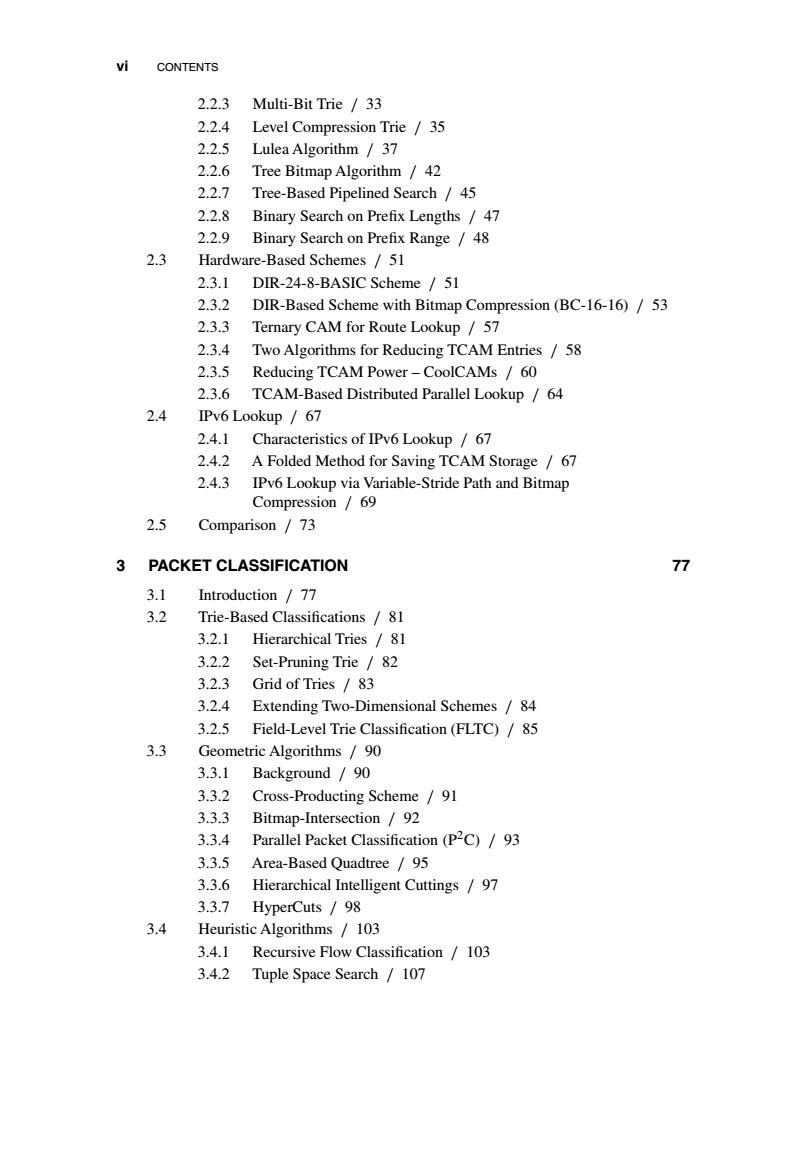
vi CONTENTS 2.2.3 Multi-Bit Trie /33 2.2.4 Level Compression Trie /35 2.2.5 Lulea Algorithm 37 2.2.6 Tree Bitmap Algorithm /42 2.2.7 Tree-Based Pipelined Search /45 2.2.8 Binary Search on Prefix Lengths /47 2.2.9 Binary Search on Prefix Range 48 2.3 Hardware-Based Schemes /51 2.3.1 DIR-24-8-BASIC Scheme /51 2.3.2 DIR-Based Scheme with Bitmap Compression(BC-16-16)/53 2.3.3 Ternary CAM for Route Lookup /57 2.3.4 Two Algorithms for Reducing TCAM Entries /58 2.3.5 Reducing TCAM Power-CoolCAMs 60 2.3.6 TCAM-Based Distributed Parallel Lookup /64 2.4 IPv6 Lookup /67 2.4.1 Characteristics of IPv6 Lookup /67 2.4.2 A Folded Method for Saving TCAM Storage /67 2.4.3 IPv6 Lookup via Variable-Stride Path and Bitmap Compression /69 2.5 Comparison /73 3 PACKET CLASSIFICATION 77 3.1 Introduction /77 3.2 Trie-Based Classifications /81 3.2.1 Hierarchical Tries /81 3.2.2 Set-Pruning Trie /82 3.2.3 Grid of Tries /83 3.2.4 Extending Two-Dimensional Schemes /84 3.2.5 Field-Level Trie Classification (FLTC)/85 3.3 Geometric Algorithms /90 3.3.1 Background /90 3.3.2 Cross-Producting Scheme /91 3.3.3 Bitmap-Intersection /92 3.3.4 Parallel Packet Classification (P2C)/93 3.3.5 Area-Based Quadtree /95 3.3.6 Hierarchical Intelligent Cuttings /97 3.3.7 HyperCuts /98 3.4 Heuristic Algorithms /103 3.4.1 Recursive Flow Classification 103 3.4.2 Tuple Space Search /107
Book1099 — “ftoc” — 2007/2/16 — 21:26 — page vi — #2 vi CONTENTS 2.2.3 Multi-Bit Trie / 33 2.2.4 Level Compression Trie / 35 2.2.5 Lulea Algorithm / 37 2.2.6 Tree Bitmap Algorithm / 42 2.2.7 Tree-Based Pipelined Search / 45 2.2.8 Binary Search on Prefix Lengths / 47 2.2.9 Binary Search on Prefix Range / 48 2.3 Hardware-Based Schemes / 51 2.3.1 DIR-24-8-BASIC Scheme / 51 2.3.2 DIR-Based Scheme with Bitmap Compression (BC-16-16) / 53 2.3.3 Ternary CAM for Route Lookup / 57 2.3.4 Two Algorithms for Reducing TCAM Entries / 58 2.3.5 Reducing TCAM Power – CoolCAMs / 60 2.3.6 TCAM-Based Distributed Parallel Lookup / 64 2.4 IPv6 Lookup / 67 2.4.1 Characteristics of IPv6 Lookup / 67 2.4.2 A Folded Method for Saving TCAM Storage / 67 2.4.3 IPv6 Lookup via Variable-Stride Path and Bitmap Compression / 69 2.5 Comparison / 73 3 PACKET CLASSIFICATION 77 3.1 Introduction / 77 3.2 Trie-Based Classifications / 81 3.2.1 Hierarchical Tries / 81 3.2.2 Set-Pruning Trie / 82 3.2.3 Grid of Tries / 83 3.2.4 Extending Two-Dimensional Schemes / 84 3.2.5 Field-Level Trie Classification (FLTC) / 85 3.3 Geometric Algorithms / 90 3.3.1 Background / 90 3.3.2 Cross-Producting Scheme / 91 3.3.3 Bitmap-Intersection / 92 3.3.4 Parallel Packet Classification (P2C) / 93 3.3.5 Area-Based Quadtree / 95 3.3.6 Hierarchical Intelligent Cuttings / 97 3.3.7 HyperCuts / 98 3.4 Heuristic Algorithms / 103 3.4.1 Recursive Flow Classification / 103 3.4.2 Tuple Space Search / 107
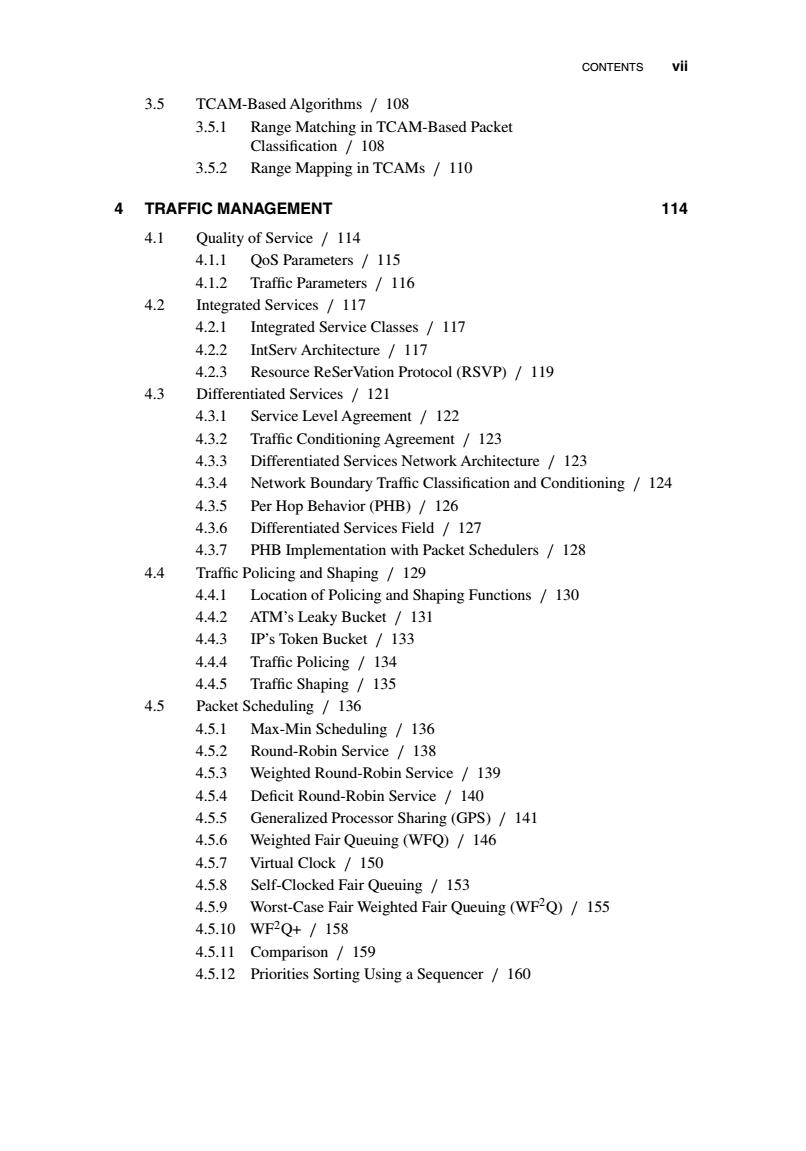
CONTENTS vii 3.5 TCAM-Based Algorithms 108 3.5.1 Range Matching in TCAM-Based Packet Classification 108 3.5.2 Range Mapping in TCAMs 110 4 TRAFFIC MANAGEMENT 114 4.1 Quality of Service /114 4.1.1 QoS Parameters 115 4.1.2 Traffic Parameters /116 4.2 Integrated Services 117 4.2.1 Integrated Service Classes 117 4.2.2 IntServ Architecture 117 4.2.3 Resource ReSer Vation Protocol(RSVP)/119 4.3 Differentiated Services /121 4.3.1 Service Level Agreement /122 4.3.2 Traffic Conditioning Agreement /123 4.3.3 Differentiated Services Network Architecture 123 4.3.4 Network Boundary Traffic Classification and Conditioning /124 4.3.5 Per Hop Behavior(PHB)/126 4.3.6 Differentiated Services Field 127 4.3.7 PHB Implementation with Packet Schedulers 128 4.4 Traffic Policing and Shaping /129 4.4.1 Location of Policing and Shaping Functions 130 4.4.2 ATM's Leaky Bucket 131 4.4.3 IP's Token Bucket 133 4.4.4 Traffic Policing /134 4.4.5 Traffic Shaping 135 45 Packet Scheduling /136 4.5.1 Max-Min Scheduling 136 4.5.2 Round-Robin Service 138 4.5.3 Weighted Round-Robin Service /139 4.5.4 Deficit Round-Robin Service 140 4.5.5 Generalized Processor Sharing(GPS)/141 4.5.6 Weighted Fair Queuing (WFQ)/146 4.5.7 Virtual Clock 150 4.5.8 Self-Clocked Fair Queuing 153 4.5.9 Worst-Case Fair Weighted Fair Queuing (WP2Q)/155 4.5.10W℉2Q+/158 4.5.11 Comparison /159 4.5.12 Priorities Sorting Using a Sequencer /160
Book1099 — “ftoc” — 2007/2/16 — 21:26 — page vii — #3 CONTENTS vii 3.5 TCAM-Based Algorithms / 108 3.5.1 Range Matching in TCAM-Based Packet Classification / 108 3.5.2 Range Mapping in TCAMs / 110 4 TRAFFIC MANAGEMENT 114 4.1 Quality of Service / 114 4.1.1 QoS Parameters / 115 4.1.2 Traffic Parameters / 116 4.2 Integrated Services / 117 4.2.1 Integrated Service Classes / 117 4.2.2 IntServ Architecture / 117 4.2.3 Resource ReSerVation Protocol (RSVP) / 119 4.3 Differentiated Services / 121 4.3.1 Service Level Agreement / 122 4.3.2 Traffic Conditioning Agreement / 123 4.3.3 Differentiated Services Network Architecture / 123 4.3.4 Network Boundary Traffic Classification and Conditioning / 124 4.3.5 Per Hop Behavior (PHB) / 126 4.3.6 Differentiated Services Field / 127 4.3.7 PHB Implementation with Packet Schedulers / 128 4.4 Traffic Policing and Shaping / 129 4.4.1 Location of Policing and Shaping Functions / 130 4.4.2 ATM’s Leaky Bucket / 131 4.4.3 IP’s Token Bucket / 133 4.4.4 Traffic Policing / 134 4.4.5 Traffic Shaping / 135 4.5 Packet Scheduling / 136 4.5.1 Max-Min Scheduling / 136 4.5.2 Round-Robin Service / 138 4.5.3 Weighted Round-Robin Service / 139 4.5.4 Deficit Round-Robin Service / 140 4.5.5 Generalized Processor Sharing (GPS) / 141 4.5.6 Weighted Fair Queuing (WFQ) / 146 4.5.7 Virtual Clock / 150 4.5.8 Self-Clocked Fair Queuing / 153 4.5.9 Worst-Case Fair Weighted Fair Queuing (WF2Q) / 155 4.5.10 WF2Q+ / 158 4.5.11 Comparison / 159 4.5.12 Priorities Sorting Using a Sequencer / 160
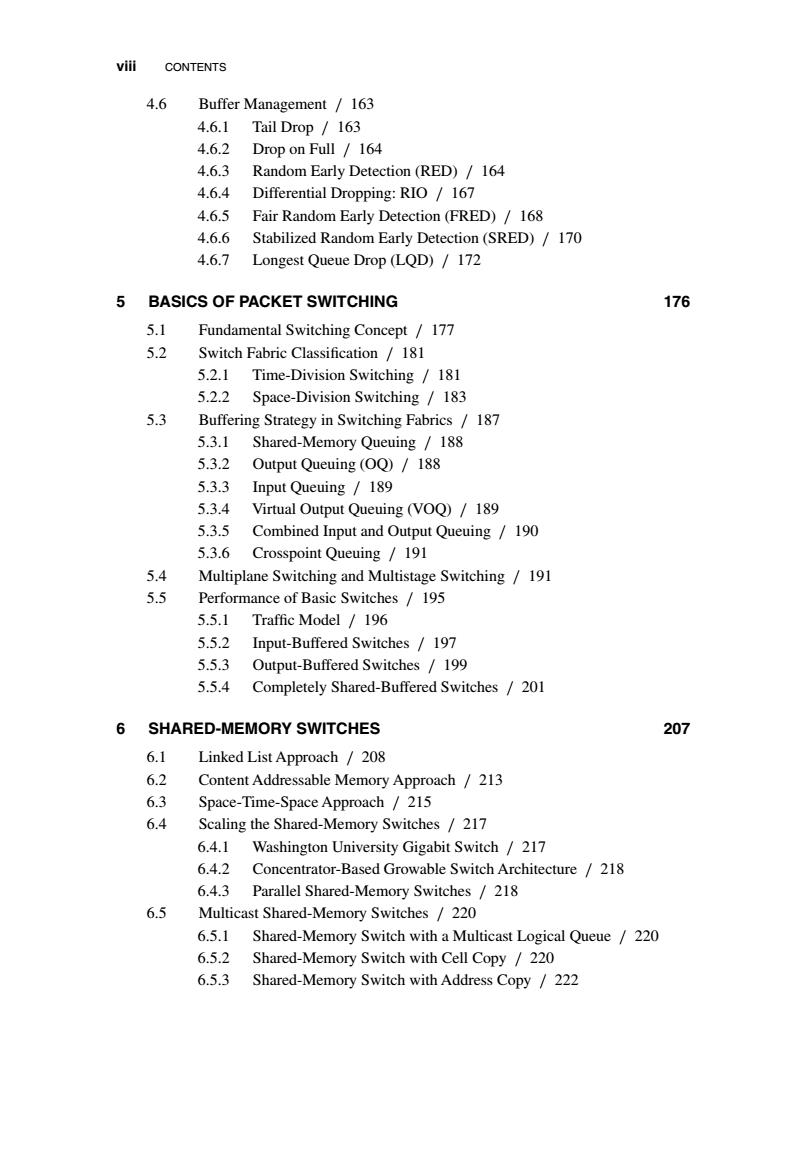
viii CONTENTS 4.6 Buffer Management 163 4.6.1 Tail Drop 163 4.6.2 Drop on Full 164 4.6.3 Random Early Detection(RED)/164 4.6.4 Differential Dropping:RIO 167 4.6.5 Fair Random Early Detection(FRED)/168 4.6.6 Stabilized Random Early Detection(SRED)/170 4.6.7 Longest Queue Drop (LQD)/172 5 BASICS OF PACKET SWITCHING 176 5.1 Fundamental Switching Concept 177 5.2 Switch Fabric Classification /181 5.2.1 Time-Division Switching 181 5.2.2 Space-Division Switching 183 5.3 Buffering Strategy in Switching Fabrics /187 5.3.1 Shared-Memory Queuing 188 5.3.2 Output Queuing(OQ)/188 5.3.3 Input Queuing 189 5.3.4 Virtual Output Queuing (VOQ)/189 5.3.5 Combined Input and Output Queuing /190 5.3.6 Crosspoint Queuing 191 5.4 Multiplane Switching and Multistage Switching /191 5.5 Performance of Basic Switches /195 5.5.1 Traffic Model 196 5.5.2 Input-Buffered Switches /197 5.5.3 Output-Buffered Switches 199 5.5.4 Completely Shared-Buffered Switches /201 6 SHARED-MEMORY SWITCHES 207 6.1 Linked List Approach 208 6.2 Content Addressable Memory Approach /213 6.3 Space-Time-Space Approach 215 6.4 Scaling the Shared-Memory Switches /217 6.4.1 Washington University Gigabit Switch /217 6.4.2 Concentrator-Based Growable Switch Architecture /218 6.4.3 Parallel Shared-Memory Switches 218 6.5 Multicast Shared-Memory Switches 220 6.5.1 Shared-Memory Switch with a Multicast Logical Queue 220 6.5.2 Shared-Memory Switch with Cell Copy /220 6.5.3 Shared-Memory Switch with Address Copy 222
Book1099 — “ftoc” — 2007/2/16 — 21:26 — page viii — #4 viii CONTENTS 4.6 Buffer Management / 163 4.6.1 Tail Drop / 163 4.6.2 Drop on Full / 164 4.6.3 Random Early Detection (RED) / 164 4.6.4 Differential Dropping: RIO / 167 4.6.5 Fair Random Early Detection (FRED) / 168 4.6.6 Stabilized Random Early Detection (SRED) / 170 4.6.7 Longest Queue Drop (LQD) / 172 5 BASICS OF PACKET SWITCHING 176 5.1 Fundamental Switching Concept / 177 5.2 Switch Fabric Classification / 181 5.2.1 Time-Division Switching / 181 5.2.2 Space-Division Switching / 183 5.3 Buffering Strategy in Switching Fabrics / 187 5.3.1 Shared-Memory Queuing / 188 5.3.2 Output Queuing (OQ) / 188 5.3.3 Input Queuing / 189 5.3.4 Virtual Output Queuing (VOQ) / 189 5.3.5 Combined Input and Output Queuing / 190 5.3.6 Crosspoint Queuing / 191 5.4 Multiplane Switching and Multistage Switching / 191 5.5 Performance of Basic Switches / 195 5.5.1 Traffic Model / 196 5.5.2 Input-Buffered Switches / 197 5.5.3 Output-Buffered Switches / 199 5.5.4 Completely Shared-Buffered Switches / 201 6 SHARED-MEMORY SWITCHES 207 6.1 Linked List Approach / 208 6.2 Content Addressable Memory Approach / 213 6.3 Space-Time-Space Approach / 215 6.4 Scaling the Shared-Memory Switches / 217 6.4.1 Washington University Gigabit Switch / 217 6.4.2 Concentrator-Based Growable Switch Architecture / 218 6.4.3 Parallel Shared-Memory Switches / 218 6.5 Multicast Shared-Memory Switches / 220 6.5.1 Shared-Memory Switch with a Multicast Logical Queue / 220 6.5.2 Shared-Memory Switch with Cell Copy / 220 6.5.3 Shared-Memory Switch with Address Copy / 222
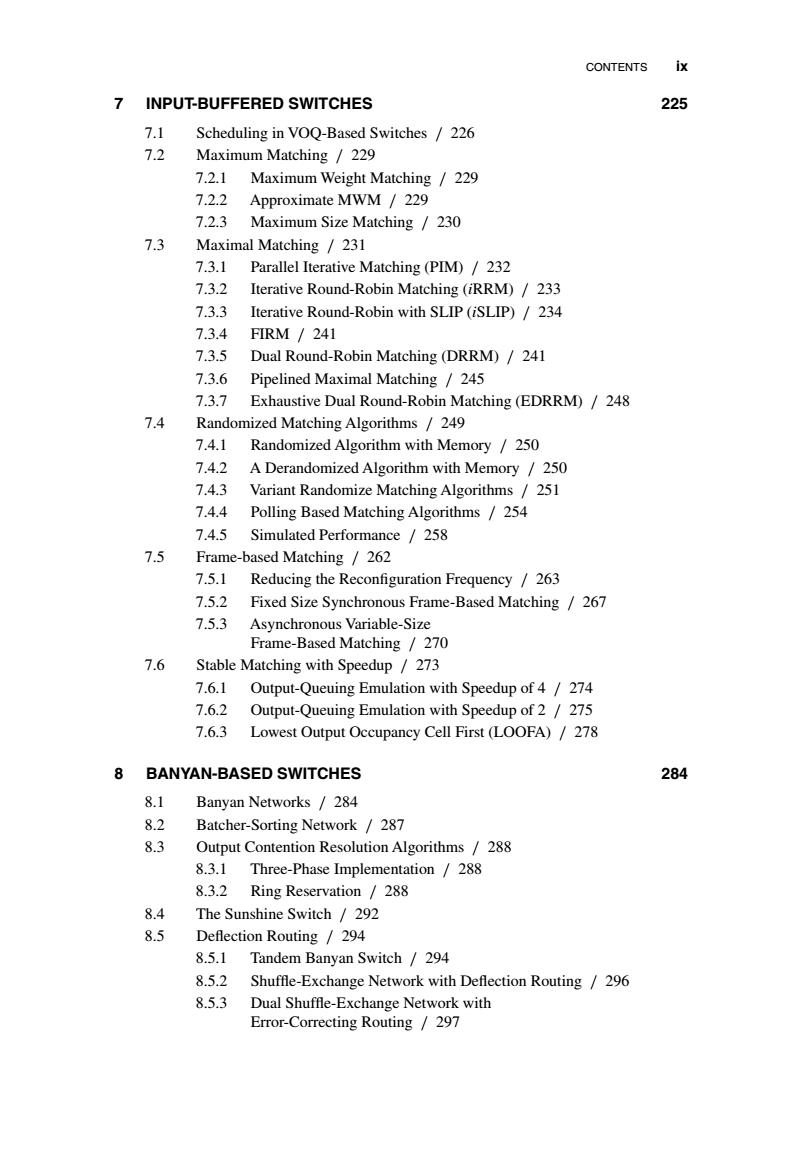
CONTENTS ix 7 INPUT-BUFFERED SWITCHES 225 7.1 Scheduling in VOQ-Based Switches /226 7.2 Maximum Matching /229 7.2.1 Maximum Weight Matching /229 7.2.2 Approximate MWM /229 7.2.3 Maximum Size Matching /230 7.3 Maximal Matching 231 7.3.1 Parallel Iterative Matching(PIM)/232 7.3.2 Iterative Round-Robin Matching(iRRM)/233 7.3.3 Iterative Round-Robin with SLIP (iSLIP)/234 7.3.4FIRM/241 7.3.5 Dual Round-Robin Matching(DRRM)/241 7.3.6 Pipelined Maximal Matching /245 7.3.7 Exhaustive Dual Round-Robin Matching (EDRRM)/248 7.4 Randomized Matching Algorithms 249 7.4.1 Randomized Algorithm with Memory /250 7.4.2 A Derandomized Algorithm with Memory 250 7.4.3 Variant Randomize Matching Algorithms /251 7.4.4 Polling Based Matching Algorithms /254 7.4.5 Simulated Performance /258 7.5 Frame-based Matching /262 7.5.1 Reducing the Reconfiguration Frequency /263 7.5.2 Fixed Size Synchronous Frame-Based Matching /267 7.5.3 Asynchronous Variable-Size Frame-Based Matching /270 7.6 Stable Matching with Speedup /273 7.6.1 Output-Queuing Emulation with Speedup of 4 274 7.6.2 Output-Queuing Emulation with Speedup of 2 /275 7.6.3 Lowest Output Occupancy Cell First(LOOFA)/278 8 BANYAN-BASED SWITCHES 284 8.1 Banyan Networks 284 8.2 Batcher-Sorting Network 287 8.3 Output Contention Resolution Algorithms /288 8.3.1 Three-Phase Implementation 288 8.3.2 Ring Reservation 288 8.4 The Sunshine Switch /292 8.5 Deflection Routing /294 8.5.1 Tandem Banyan Switch 294 8.5.2 Shuffle-Exchange Network with Deflection Routing /296 8.5.3 Dual Shuffle-Exchange Network with Error-Correcting Routing /297
Book1099 — “ftoc” — 2007/2/16 — 21:26 — page ix — #5 CONTENTS ix 7 INPUT-BUFFERED SWITCHES 225 7.1 Scheduling in VOQ-Based Switches / 226 7.2 Maximum Matching / 229 7.2.1 Maximum Weight Matching / 229 7.2.2 Approximate MWM / 229 7.2.3 Maximum Size Matching / 230 7.3 Maximal Matching / 231 7.3.1 Parallel Iterative Matching (PIM) / 232 7.3.2 Iterative Round-Robin Matching (iRRM) / 233 7.3.3 Iterative Round-Robin with SLIP (iSLIP) / 234 7.3.4 FIRM / 241 7.3.5 Dual Round-Robin Matching (DRRM) / 241 7.3.6 Pipelined Maximal Matching / 245 7.3.7 Exhaustive Dual Round-Robin Matching (EDRRM) / 248 7.4 Randomized Matching Algorithms / 249 7.4.1 Randomized Algorithm with Memory / 250 7.4.2 A Derandomized Algorithm with Memory / 250 7.4.3 Variant Randomize Matching Algorithms / 251 7.4.4 Polling Based Matching Algorithms / 254 7.4.5 Simulated Performance / 258 7.5 Frame-based Matching / 262 7.5.1 Reducing the Reconfiguration Frequency / 263 7.5.2 Fixed Size Synchronous Frame-Based Matching / 267 7.5.3 Asynchronous Variable-Size Frame-Based Matching / 270 7.6 Stable Matching with Speedup / 273 7.6.1 Output-Queuing Emulation with Speedup of 4 / 274 7.6.2 Output-Queuing Emulation with Speedup of 2 / 275 7.6.3 Lowest Output Occupancy Cell First (LOOFA) / 278 8 BANYAN-BASED SWITCHES 284 8.1 Banyan Networks / 284 8.2 Batcher-Sorting Network / 287 8.3 Output Contention Resolution Algorithms / 288 8.3.1 Three-Phase Implementation / 288 8.3.2 Ring Reservation / 288 8.4 The Sunshine Switch / 292 8.5 Deflection Routing / 294 8.5.1 Tandem Banyan Switch / 294 8.5.2 Shuffle-Exchange Network with Deflection Routing / 296 8.5.3 Dual Shuffle-Exchange Network with Error-Correcting Routing / 297

CONTENTS 8.6 Multicast Copy Networks 303 8.6.1 Broadcast Banyan Network /304 8.6.2 Encoding Process /308 8.6.3 Concentration /309 8.6.4 Decoding Process /310 8.6.5 Overflow and Call Splitting /310 8.6.6 Overflow and Input Fairness 311 9 KNOCKOUT-BASED SWITCHES 316 9.1 Single-Stage Knockout Switch /317 9.1.1 Basic Architecture /317 9.1.2 Knockout Concentration Principle /318 9.1.3 Construction of the Concentrator /320 9.2 Channel Grouping Principle /323 9.2.1 Maximum Throughput /324 9.2.2 Generalized Knockout Principle 325 9.3 Two-Stage Multicast Output-Buffered ATM Switch(MOBAS)/327 9.3.1 Two-Stage Configuration /327 9.3.2 Multicast Grouping Network (MGN)/330 9.4 Appendix /333 10 THE ABACUS SWITCH 336 10.1 Basic Architecture /337 10.2 Multicast Contention Resolution Algorithm /340 10.3 Implementation of Input Port Controller /342 10.4 Performance /344 10.4.1 Maximum Throughput /344 10.4.2 Average Delay /347 10.4.3 Cell Loss Probability 349 10.5 ATM Routing and Concentration (ARC)Chip 351 10.6 Enhanced Abacus Switch 354 10.6.1 Memoryless Multi-Stage Concentration Network /354 10.6.2 Buffered Multi-Stage Concentration Network 357 10.6.3 Resequencing Cells /359 10.6.4 Complexity Comparison 361 10.7 Abacus Switch for Packet Switching /362 10.7.1 Packet Interleaving 362 10.7.2 Cell Interleaving 364 11 CROSSPOINT BUFFERED SWITCHES 367 11.1 Combined Input and Crosspoint Buffered Switches /368
Book1099 — “ftoc” — 2007/2/16 — 21:26 — page x — #6 x CONTENTS 8.6 Multicast Copy Networks / 303 8.6.1 Broadcast Banyan Network / 304 8.6.2 Encoding Process / 308 8.6.3 Concentration / 309 8.6.4 Decoding Process / 310 8.6.5 Overflow and Call Splitting / 310 8.6.6 Overflow and Input Fairness / 311 9 KNOCKOUT-BASED SWITCHES 316 9.1 Single-Stage Knockout Switch / 317 9.1.1 Basic Architecture / 317 9.1.2 Knockout Concentration Principle / 318 9.1.3 Construction of the Concentrator / 320 9.2 Channel Grouping Principle / 323 9.2.1 Maximum Throughput / 324 9.2.2 Generalized Knockout Principle / 325 9.3 Two-Stage Multicast Output-Buffered ATM Switch (MOBAS) / 327 9.3.1 Two-Stage Configuration / 327 9.3.2 Multicast Grouping Network (MGN) / 330 9.4 Appendix / 333 10 THE ABACUS SWITCH 336 10.1 Basic Architecture / 337 10.2 Multicast Contention Resolution Algorithm / 340 10.3 Implementation of Input Port Controller / 342 10.4 Performance / 344 10.4.1 Maximum Throughput / 344 10.4.2 Average Delay / 347 10.4.3 Cell Loss Probability / 349 10.5 ATM Routing and Concentration (ARC) Chip / 351 10.6 Enhanced Abacus Switch / 354 10.6.1 Memoryless Multi-Stage Concentration Network / 354 10.6.2 Buffered Multi-Stage Concentration Network / 357 10.6.3 Resequencing Cells / 359 10.6.4 Complexity Comparison / 361 10.7 Abacus Switch for Packet Switching / 362 10.7.1 Packet Interleaving / 362 10.7.2 Cell Interleaving / 364 11 CROSSPOINT BUFFERED SWITCHES 367 11.1 Combined Input and Crosspoint Buffered Switches / 368
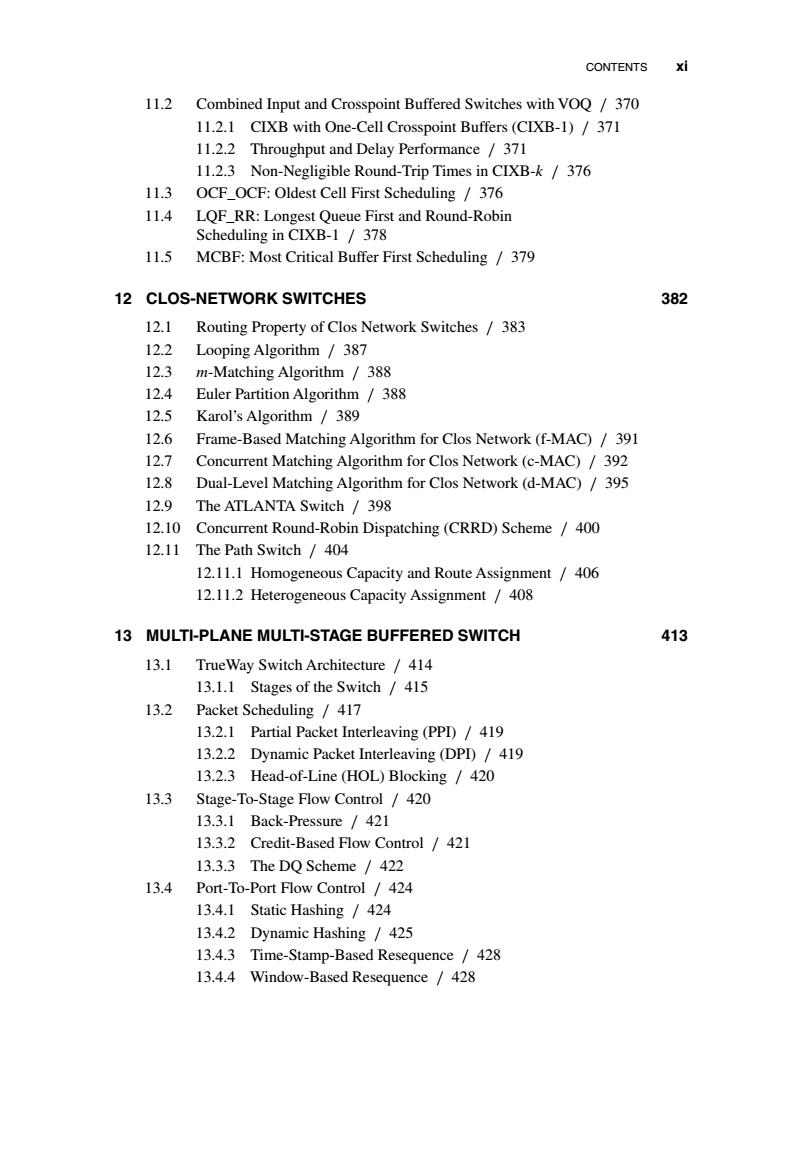
CONTENTS xi 11.2 Combined Input and Crosspoint Buffered Switches with VOQ 370 11.2.1 CIXB with One-Cell Crosspoint Buffers (CIXB-1)/371 11.2.2 Throughput and Delay Performance 371 11.2.3 Non-Negligible Round-Trip Times in CIXB-k 376 11.3 OCF_OCF:Oldest Cell First Scheduling /376 11.4 LQF_RR:Longest Queue First and Round-Robin Scheduling in CIXB-1 378 11.5 MCBF:Most Critical Buffer First Scheduling /379 12 CLOS-NETWORK SWITCHES 382 12.1 Routing Property of Clos Network Switches /383 12.2 Looping Algorithm 387 12.3 m-Matching Algorithm /388 12.4 Euler Partition Algorithm /388 12.5 Karol's Algorithm /389 12.6 Frame-Based Matching Algorithm for Clos Network(f-MAC)/391 12.7 Concurrent Matching Algorithm for Clos Network(c-MAC)/392 12.8 Dual-Level Matching Algorithm for Clos Network (d-MAC)/395 12.9 The ATLANTA Switch 398 12.10 Concurrent Round-Robin Dispatching(CRRD)Scheme /400 12.11 The Path Switch 404 12.11.1 Homogeneous Capacity and Route Assignment /406 12.11.2 Heterogeneous Capacity Assignment /408 13 MULTI-PLANE MULTI-STAGE BUFFERED SWITCH 413 13.1 TrueWay Switch Architecture /414 13.1.1 Stages of the Switch /415 13.2 Packet Scheduling /417 13.2.1 Partial Packet Interleaving (PPD)/419 13.2.2 Dynamic Packet Interleaving (DPI)/419 13.2.3 Head-of-Line (HOL)Blocking /420 13.3 Stage-To-Stage Flow Control /420 13.3.1 Back-Pressure /421 13.3.2 Credit-Based Flow Control /421 13.3.3 The DQ Scheme /422 13.4 Port-To-Port Flow Control /424 13.4.1 Static Hashing /424 13.4.2 Dynamic Hashing /425 13.4.3 Time-Stamp-Based Resequence /428 13.4.4 Window-Based Resequence /428
Book1099 — “ftoc” — 2007/2/16 — 21:26 — page xi — #7 CONTENTS xi 11.2 Combined Input and Crosspoint Buffered Switches with VOQ / 370 11.2.1 CIXB with One-Cell Crosspoint Buffers (CIXB-1) / 371 11.2.2 Throughput and Delay Performance / 371 11.2.3 Non-Negligible Round-Trip Times in CIXB-k / 376 11.3 OCF_OCF: Oldest Cell First Scheduling / 376 11.4 LQF_RR: Longest Queue First and Round-Robin Scheduling in CIXB-1 / 378 11.5 MCBF: Most Critical Buffer First Scheduling / 379 12 CLOS-NETWORK SWITCHES 382 12.1 Routing Property of Clos Network Switches / 383 12.2 Looping Algorithm / 387 12.3 m-Matching Algorithm / 388 12.4 Euler Partition Algorithm / 388 12.5 Karol’s Algorithm / 389 12.6 Frame-Based Matching Algorithm for Clos Network (f-MAC) / 391 12.7 Concurrent Matching Algorithm for Clos Network (c-MAC) / 392 12.8 Dual-Level Matching Algorithm for Clos Network (d-MAC) / 395 12.9 The ATLANTA Switch / 398 12.10 Concurrent Round-Robin Dispatching (CRRD) Scheme / 400 12.11 The Path Switch / 404 12.11.1 Homogeneous Capacity and Route Assignment / 406 12.11.2 Heterogeneous Capacity Assignment / 408 13 MULTI-PLANE MULTI-STAGE BUFFERED SWITCH 413 13.1 TrueWay Switch Architecture / 414 13.1.1 Stages of the Switch / 415 13.2 Packet Scheduling / 417 13.2.1 Partial Packet Interleaving (PPI) / 419 13.2.2 Dynamic Packet Interleaving (DPI) / 419 13.2.3 Head-of-Line (HOL) Blocking / 420 13.3 Stage-To-Stage Flow Control / 420 13.3.1 Back-Pressure / 421 13.3.2 Credit-Based Flow Control / 421 13.3.3 The DQ Scheme / 422 13.4 Port-To-Port Flow Control / 424 13.4.1 Static Hashing / 424 13.4.2 Dynamic Hashing / 425 13.4.3 Time-Stamp-Based Resequence / 428 13.4.4 Window-Based Resequence / 428

xii CONTENTS 13.5 Performance Analysis /431 13.5.1 Random Uniform Traffic 431 13.5.2 Hot-Spot Traffic /432 13.5.3 Bursty Traffic /432 13.5.4 Hashing Schemes /432 13.5.5 Window-Based Resequencing Scheme /434 13.6 Prototype /434 14 LOAD-BALANCED SWITCHES 438 14.1 Birkhoff-Von Neumann Switch 438 14.2 Load-Balanced Birkhoff-von Neumann Switches /441 14.2.1 Load-Balanced Birkhoff-von Neumann Switch Architecture /441 14.2.2 Performance of Load-Balanced Birkhoff-von Neumann Switches /442 14.3 Load-Balanced Birkhoff-von Neumann Switches With FIFO Service /444 14.3.1 First Come First Served(FCFS)/446 14.3.2 Earliest Deadline First(EDF)and EDF-3DQ /450 14.3.3 Full Frames First(FFF)/451 14.3.4 Full Ordered Frames First(FOFF)/455 14.3.5 Mailbox Switch /456 14.3.6 Byte-Focal Switch /459 15 OPTICAL PACKET SWITCHES 468 15.1 Opto-Electronic Packet Switches /469 15.1.1 Hypass/469 15.1.2 Star-Track 471 15.1.3 Cisneros and Brackett /472 15.1.4 BNR(Bell-North Research)Switch 473 15.1.5 Wave-Mux Switch 474 15.2 Optoelectronic Packet Switch Case Study I /475 15.2.1 Speedup /476 15.2.2 Data Packet Flow /477 15.2.3 Optical Interconnection Network(OIN)/477 15.2.4 Ping-Pong Arbitration Unit 482 15.3 Optoelectronic Packet Switch Case Study II /490 15.3.1 Petabit Photonic Packet Switch Architecture /490 15.3.2 Photonic Switch Fabric (PSF)/495 15.4 All Optical Packet Switches 503 15.4.1 The Staggering Switch 503 15.4.2ATM0S/504
Book1099 — “ftoc” — 2007/2/16 — 21:26 — page xii — #8 xii CONTENTS 13.5 Performance Analysis / 431 13.5.1 Random Uniform Traffic / 431 13.5.2 Hot-Spot Traffic / 432 13.5.3 Bursty Traffic / 432 13.5.4 Hashing Schemes / 432 13.5.5 Window-Based Resequencing Scheme / 434 13.6 Prototype / 434 14 LOAD-BALANCED SWITCHES 438 14.1 Birkhoff–Von Neumann Switch / 438 14.2 Load-Balanced Birkhoff–von Neumann Switches / 441 14.2.1 Load-Balanced Birkhoff–von Neumann Switch Architecture / 441 14.2.2 Performance of Load-Balanced Birkhoff–von Neumann Switches / 442 14.3 Load-Balanced Birkhoff–von Neumann Switches With FIFO Service / 444 14.3.1 First Come First Served (FCFS) / 446 14.3.2 Earliest Deadline First (EDF) and EDF-3DQ / 450 14.3.3 Full Frames First (FFF) / 451 14.3.4 Full Ordered Frames First (FOFF) / 455 14.3.5 Mailbox Switch / 456 14.3.6 Byte-Focal Switch / 459 15 OPTICAL PACKET SWITCHES 468 15.1 Opto-Electronic Packet Switches / 469 15.1.1 Hypass / 469 15.1.2 Star-Track / 471 15.1.3 Cisneros and Brackett / 472 15.1.4 BNR (Bell-North Research) Switch / 473 15.1.5 Wave-Mux Switch / 474 15.2 Optoelectronic Packet Switch Case Study I / 475 15.2.1 Speedup / 476 15.2.2 Data Packet Flow / 477 15.2.3 Optical Interconnection Network (OIN) / 477 15.2.4 Ping-Pong Arbitration Unit / 482 15.3 Optoelectronic Packet Switch Case Study II / 490 15.3.1 Petabit Photonic Packet Switch Architecture / 490 15.3.2 Photonic Switch Fabric (PSF) / 495 15.4 All Optical Packet Switches / 503 15.4.1 The Staggering Switch / 503 15.4.2 ATMOS / 504
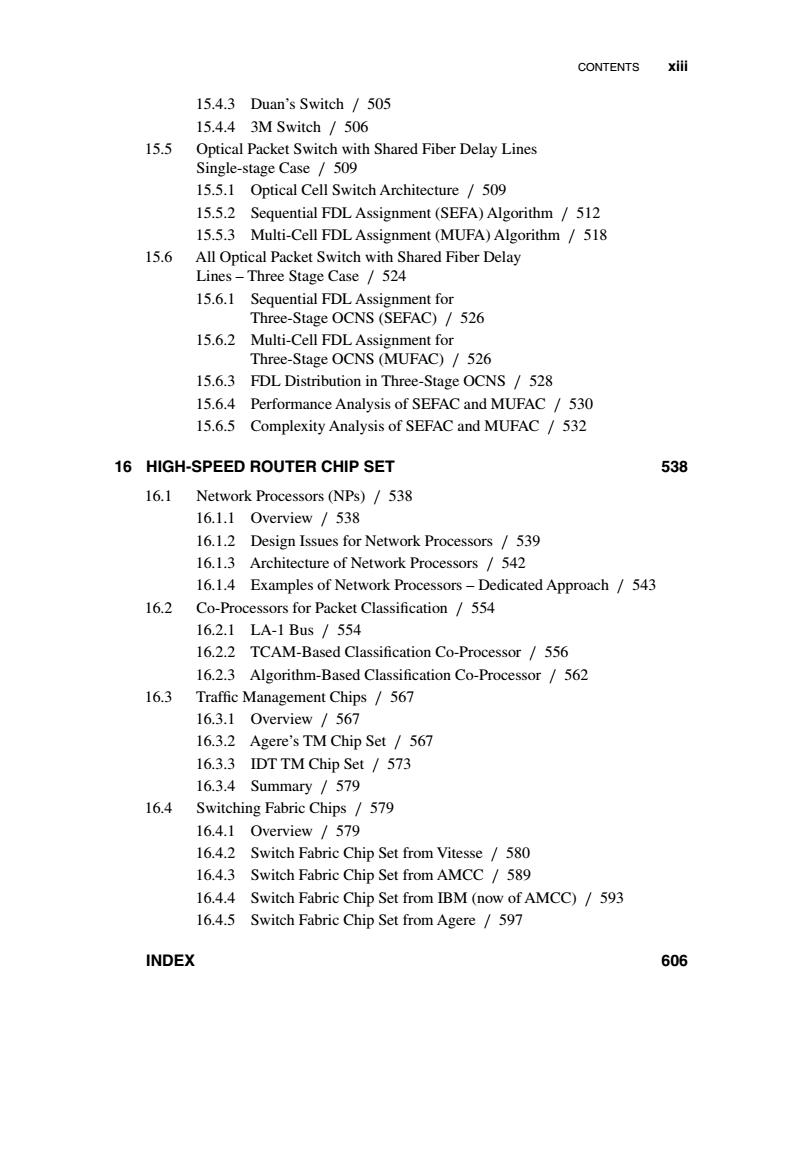
CONTENTS xiii 15.4.3 Duan's Switch 505 15.4.43 M Switch/506 15.5 Optical Packet Switch with Shared Fiber Delay Lines Single-stage Case 509 15.5.1 Optical Cell Switch Architecture 509 15.5.2 Sequential FDL Assignment(SEFA)Algorithm /512 15.5.3 Multi-Cell FDL Assignment(MUFA)Algorithm /518 15.6 All Optical Packet Switch with Shared Fiber Delay Lines-Three Stage Case 524 15.6.1 Sequential FDL Assignment for Three-Stage OCNS(SEFAC)/526 15.6.2 Multi-Cell FDL Assignment for Three-Stage OCNS(MUFAC)/526 15.6.3 FDL Distribution in Three-Stage OCNS /528 15.6.4 Performance Analysis of SEFAC and MUFAC 530 15.6.5 Complexity Analysis of SEFAC and MUFAC 532 16 HIGH-SPEED ROUTER CHIP SET 538 16.1 Network Processors(NPs)/538 16.1.1 Overview /538 16.1.2 Design Issues for Network Processors /539 16.1.3 Architecture of Network Processors 542 16.1.4 Examples of Network Processors-Dedicated Approach /543 16.2 Co-Processors for Packet Classification 554 16.2.1LA-1Bus/554 16.2.2 TCAM-Based Classification Co-Processor 556 16.2.3 Algorithm-Based Classification Co-Processor /562 16.3 Traffic Management Chips 567 16.3.1 Overview /567 16.3.2 Agere's TM Chip Set 567 16.3.3 IDT TM Chip Set 573 16.3.4 Summary /579 16.4 Switching Fabric Chips /579 16.4.1 Overview /579 16.4.2 Switch Fabric Chip Set from Vitesse /580 16.4.3 Switch Fabric Chip Set from AMCC 589 16.4.4 Switch Fabric Chip Set from IBM(now of AMCC)/593 16.4.5 Switch Fabric Chip Set from Agere /597 INDEX 606
Book1099 — “ftoc” — 2007/2/16 — 21:26 — page xiii — #9 CONTENTS xiii 15.4.3 Duan’s Switch / 505 15.4.4 3M Switch / 506 15.5 Optical Packet Switch with Shared Fiber Delay Lines Single-stage Case / 509 15.5.1 Optical Cell Switch Architecture / 509 15.5.2 Sequential FDL Assignment (SEFA) Algorithm / 512 15.5.3 Multi-Cell FDL Assignment (MUFA) Algorithm / 518 15.6 All Optical Packet Switch with Shared Fiber Delay Lines – Three Stage Case / 524 15.6.1 Sequential FDL Assignment for Three-Stage OCNS (SEFAC) / 526 15.6.2 Multi-Cell FDL Assignment for Three-Stage OCNS (MUFAC) / 526 15.6.3 FDL Distribution in Three-Stage OCNS / 528 15.6.4 Performance Analysis of SEFAC and MUFAC / 530 15.6.5 Complexity Analysis of SEFAC and MUFAC / 532 16 HIGH-SPEED ROUTER CHIP SET 538 16.1 Network Processors (NPs) / 538 16.1.1 Overview / 538 16.1.2 Design Issues for Network Processors / 539 16.1.3 Architecture of Network Processors / 542 16.1.4 Examples of Network Processors – Dedicated Approach / 543 16.2 Co-Processors for Packet Classification / 554 16.2.1 LA-1 Bus / 554 16.2.2 TCAM-Based Classification Co-Processor / 556 16.2.3 Algorithm-Based Classification Co-Processor / 562 16.3 Traffic Management Chips / 567 16.3.1 Overview / 567 16.3.2 Agere’s TM Chip Set / 567 16.3.3 IDT TM Chip Set / 573 16.3.4 Summary / 579 16.4 Switching Fabric Chips / 579 16.4.1 Overview / 579 16.4.2 Switch Fabric Chip Set from Vitesse / 580 16.4.3 Switch Fabric Chip Set from AMCC / 589 16.4.4 Switch Fabric Chip Set from IBM (now of AMCC) / 593 16.4.5 Switch Fabric Chip Set from Agere / 597 INDEX 606